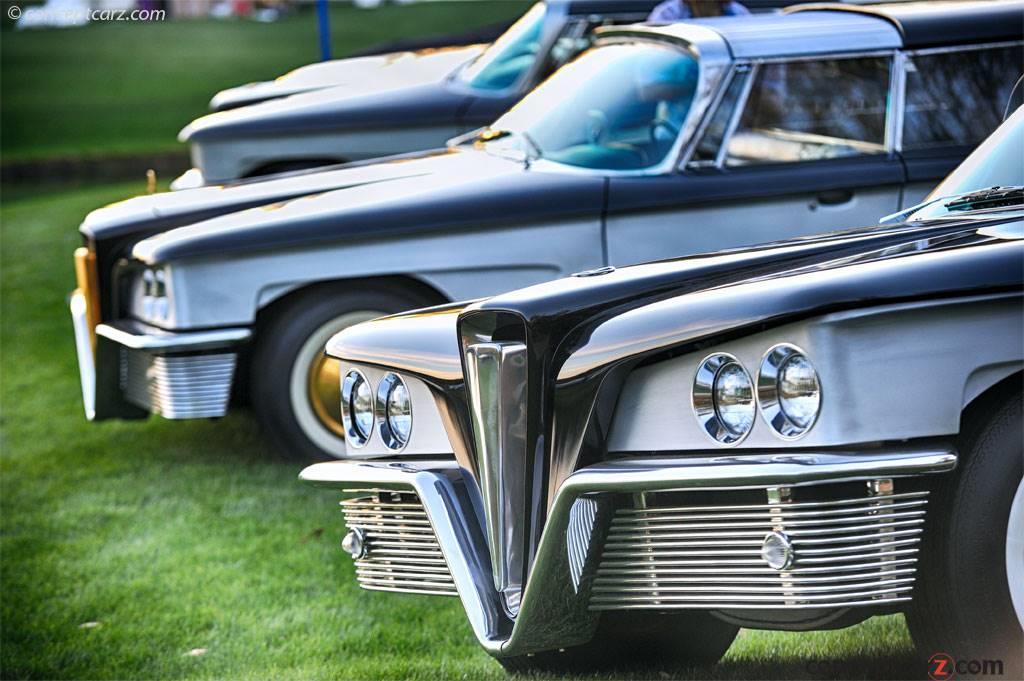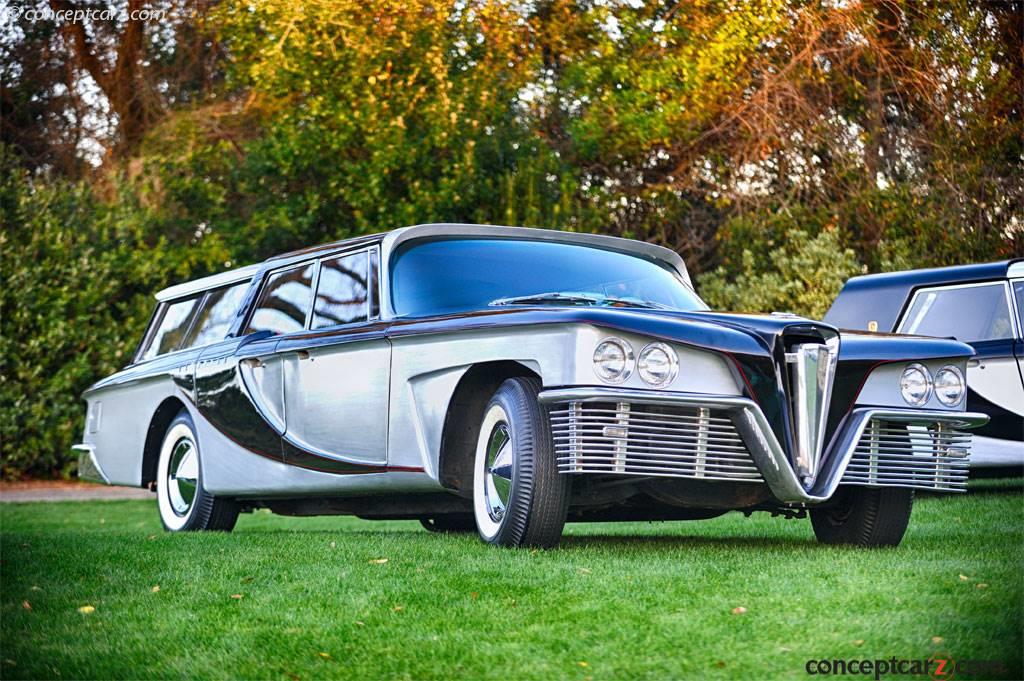The Olin Mathieson Chemical Corporation, a mining and chemical company, entered the aluminum business in the mid-1950s. Thomas S. Nicholson was the chairman of Olin and a friend of industrial designer Brooks Stevens. The aluminum had many practical applications in the construction of automobiles, so Stevens was commissioned to design three concept cars. The cars were built by Karosseriewerk Reuter of Stuttgart, Germany on mid-priced Chrysler New Yorker chassis. 
Hardtop Convertible by Reutter Karosserie
View info and historyThese marketing vehicles were used to demonstrate functional and decorative applications for aluminum use in automobiles. The aluminum anodized quarter panels could be removed for aesthetic and maintenance purposes. Lightweight anodized aluminum was used to form the grille, wheel discs, trim, bumpers, and many interior treatments. Everything that is brushed aluminum is aluminum, and the black parts are steel. The three Scimitars had the same paint schemes, the same front and rear end fascia, and the same V-shaped grille (which doubles as a bumper) that was certainly an evolution of the prior Stevens-designed Cadillac Die Valkyrie concept. The big 'V' on the Valkyrie represented the American V8 engines. Brooks Stevens raced cars in both Europe and America and was very proud of the American V8 engines and used the front bumper to symbolize it. All three Scimitars were powered by 413 cubic-inch OHV V8 engines offering 350 horsepower and backed by a TorqueFlite automatic transmission. The New Yorker's steel wheelbase measured 127 inches and its length was 216 inches. It was suspended by an independent front suspension with longitudinal torsion-bars and a rigid axle setup in the back. The curved windshield was from Chrysler and the three-round taillights were from the late-1950s Chevrolet. The Die Valkyrie was Steven's first use of the 'Washington coach' door line which featured an upward sweep that helped disguise the long door openings. A similar paint scheme and styling was applied to the Scimitar, with the name of the vehicle being inspired by the pronounced scimitar-like shape (a Turkish curved-blade saber), sweeping upwards from the lower front fender to the top of the rear fender. 
Town Car Phaeton by Reutter Karosserie
View info and historyTo demonstrate the versatility and appeal to a wide audience, a hardtop convertible, a town car phaeton, and a station wagon (all-purpose sedan) were built. The hardtop convertible is the only two-door body style in the group, and the metal roof over the passenger compartment could be fully retracted into the trunk space. Stevens had also used the retractable hardtop feature on other concepts of the early 1950s, including the Paxton Phoenix, Valkyrie, and the Gaylord Gladiator. The long rear deck and rooftop design of the Scimitar had similarities to the Ford Fairlane Skyliner of 1957, America's first production convertible with a retractable hardtop, which used a series of wires and electric motors to retract the hardtop into the trunk. With the touch of a button, the Skyliners hardtop literally unscrewed itself from the windshield frame and then folded neatly and tucked under a long, flat trunk lid that lifted on its own to make way for the top. The process took about 25 seconds to transform the Skyliner from a coupe into a true convertible. The Scimitar used two electric motors, whereas the Ford required seven.The Town Car featured a ribbed aluminum panel over the chauffeur's compartment that slid into the hollow rear roof, which could then be lowered into the trunk to create a true four-door convertible sedan. This made the Town Car Phaeton capable of being configured either as an enclosed sedan, a fully open four-door convertible sedan, or an open-front town car. A switch on the dashboard operated by the driver controlled the transformation from a sedan into a town car. Actuating the switch again automatically opened the rear-hinged deck, raised the rear roof section, and lowered it into the trunk area. The All-Purpose Family Sedan had a sliding roof panel over the cargo area. When opened, the vehicle was able to transport tall objects such as appliances or furniture. Stevens would later adopt this feature to the Studebaker Wagonaire. In the early 2000s, GM used a similar design for their Envoy XUV, which had an SUV body, a retractable roof over the cargo area, fold-down rear seats, and a removable partition.
All Purpose Sedan by Reutter Karosserie
View info and historyAfter completion, the three Scimitars were put on display at the 1959 Geneva Auto Show and then at the 1961 International Automobile Show in New York. Their promotional career lasted about three years and was shown all over, including Chicago, California, and Miami. They would remain a concept and were never offered for sale to the public. The two-door currently resides in the Petersen collection in Los Angeles, CA. The station wagon is in the National Automobile Museum (Harrah Collection) in Reno, NV and the Phaeton is in private ownership in Houston, Texas.
by Daniel Vaughan | Mar 2020

Hardtop Convertible by Reutter Karosserie
View info and history

Town Car Phaeton by Reutter Karosserie
View info and history

All Purpose Sedan by Reutter Karosserie
View info and history
by Daniel Vaughan | Mar 2020
Similar Vehicles
1959 Scimitar Concept Vehicle Profiles
Recent Vehicle Additions
Related Automotive News

The Scimitar Prototypes at The Amelia Island Concours
The 2020 Amelia Island Concours dElegance brought together the only three Scimitar automobiles ever created. This rare reunion was the first time in many decades that they sat side-by-side, a once-in-a-lifetime opportunity to see them in...

The Scimitar Prototypes at The Amelia Island Concours
The 2020 Amelia Island Concours dElegance brought together the only three Scimitar automobiles ever created. This rare reunion was the first time in many decades that they sat side-by-side, a once-in-a-lifetime opportunity to see them in...

Audi Takes A Stand On Electric Driving In Geneva
Geneva Show stand is entirely given over to fully electric and plug-in hybrid Audi models as part of major electrification offensive
Stand featuring electric vehicles exclusively
Plug-in portfolio being comprehensively expanded
Ingolstad...

Automobili Pininfarina Aligns With UK And Europe's Best Retailers Ahead Of Battista Hypercar Premiere In Geneva
Automobili Pininfarinas new global network takes shape as company prepares to launch Battista all-electric hypercar in March 2019
Sales of limited-edition Pininfarina Battista to be managed by worlds most experienced specialist car retailers*
Eu...

Academy Award-Nominated Actress Margot Robbie Headlines Nissan Formula E Launch Tour Event
Exclusive L.A. viewing of Formula E car celebrates the future of electric motorsports, technology transfer and the electrification of cities
LOS ANGELES – Nissan completed its Formula E launch tour in Los Angeles today with an event led by Margot Robbie,...
Porsche Announces New York Auto Show Line-Up
U.S. debut of the Panamera Sport Turismo, 911 GT3, Panamera Turbo S E-Hybrid, and 911 GTS
ATLANTA, April 10, 2017 -- The New York International Auto Show will serve as host to four North American debuts for Porsche this year. The Panamera...




























